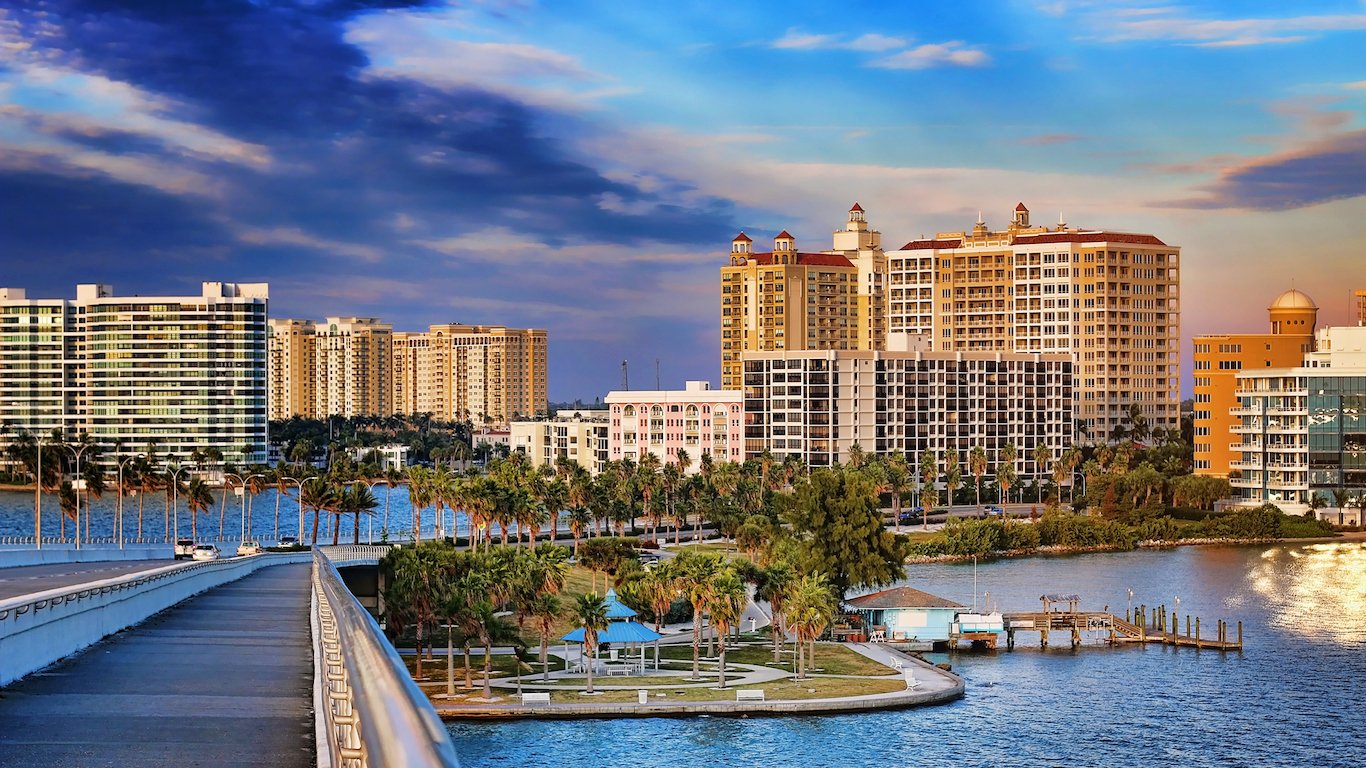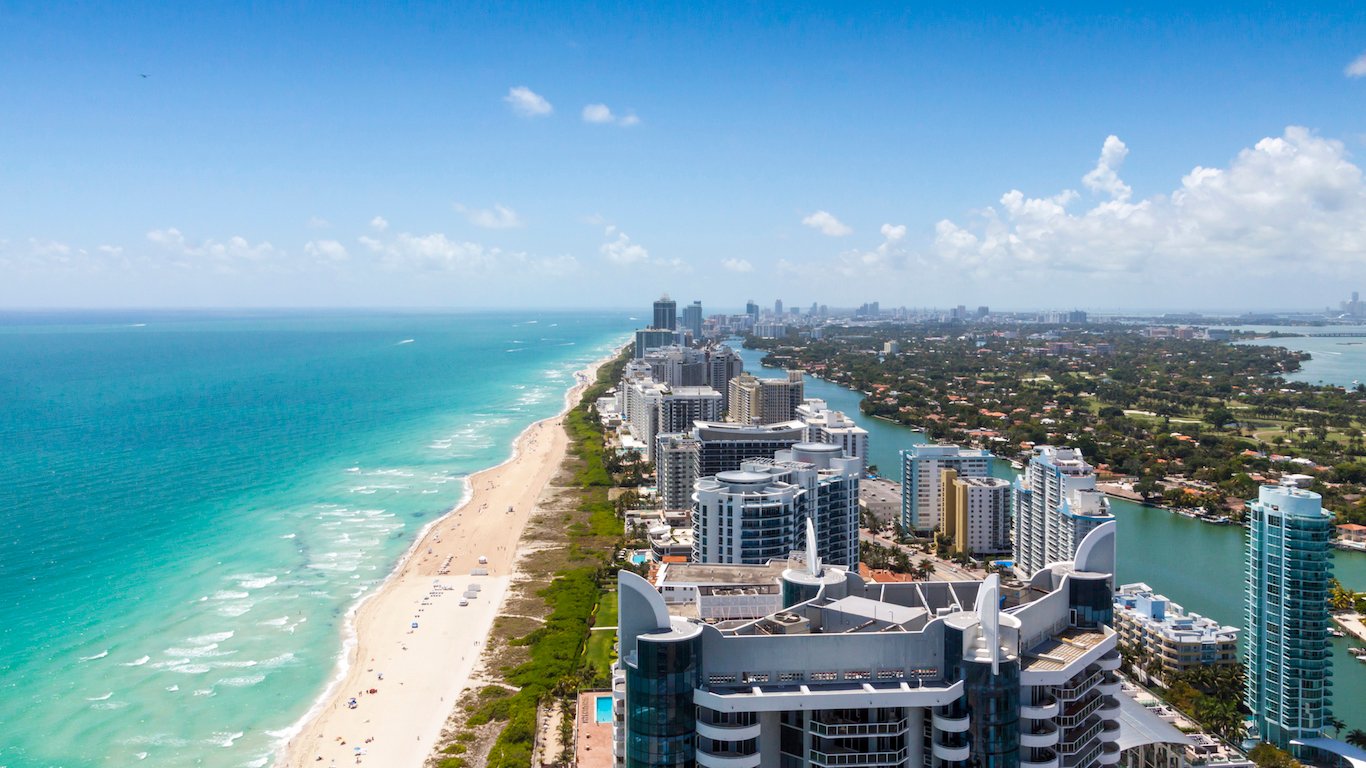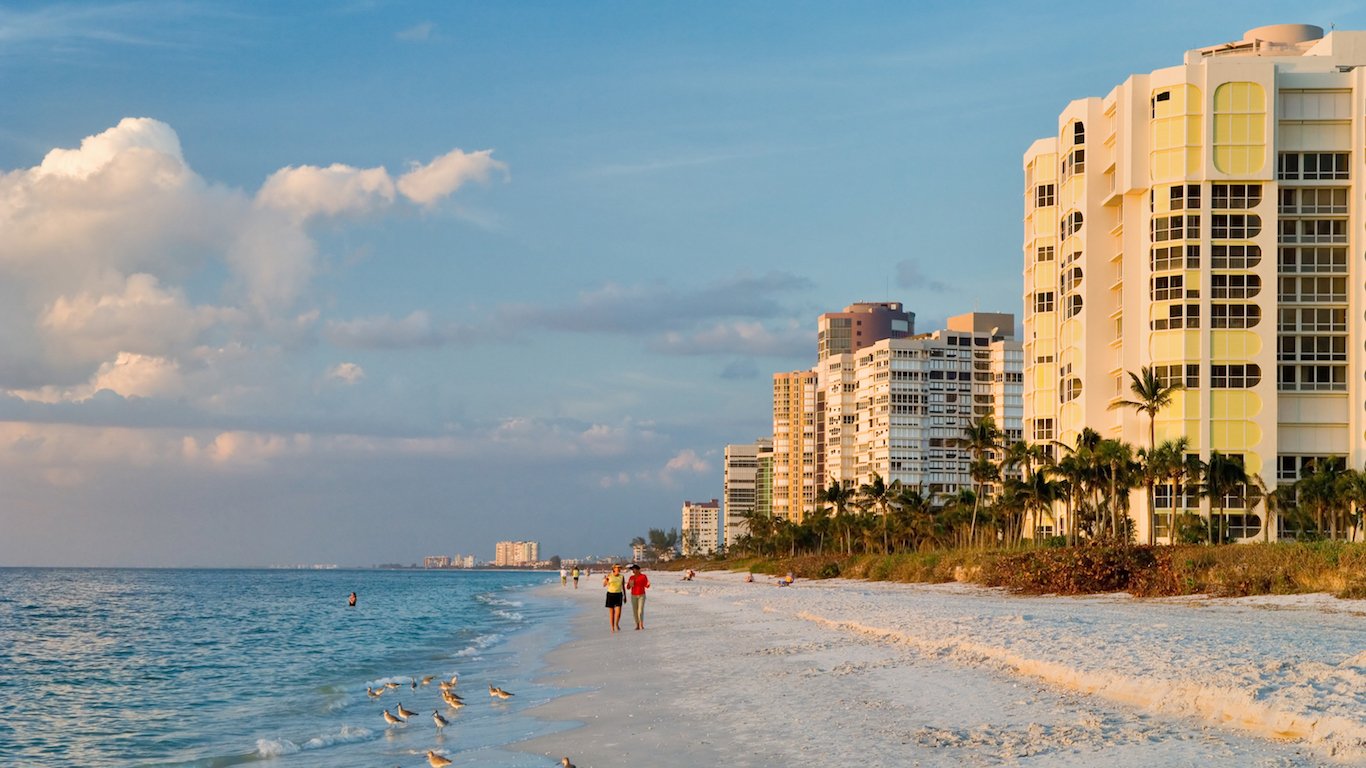

Few habits affect overall well-being more than a healthy diet, and the probability of eating well largely depends on one’s place of residence. The “2016 Community Rankings for Healthy Eating” report examines the wide range of eating habits across the nation.
According to the May 3rd report, published by Gallup-Sharecare, a partnership between the polling organization and the digital health company, 10 communities in California, four in Florida, and two each in Texas and Arizona have the healthiest eating habits in the nation. The Naples-Immokalee-Marco Island, Florida metropolitan area leads the nation, with more than 75% of residents reporting healthy eating.
24/7 Wall St. reviewed the 25 metro areas with the highest shares of residents reporting such healthy eating habits. We also examined several other factors research has shown to influence diet, as well as associated health outcomes.
Click here to see the 25 cities with the healthiest diets.
Click here to see our methodology.
In its poll, Gallup asked metro area residents, “Did you eat healthy all day yesterday?” Dan Witters, research director of the Gallup-Sharecare Well-being Index, in an interview with 24/7 Wall St. noted that while health literacy can influence how people respond to this question, “most people have a pretty good idea of what it means to eat healthy or not.”
To a large extent, in other words, healthy eating decisions are conscious choices. Several key well-being metrics, including the presence of someone who encourages you to be healthy, and notably stress levels, support healthy diets.
Of the 25 cities where the largest share of residents eat healthy diets, only in nine did residents report above-average daily stress levels. Nationwide, 40% of adults reported daily stress.
In addition to strong relationships, income levels and money management are closely related to dietary decisions. The ability to pay for high quality food is often a limiting factor for low income families. Fruits, vegetables, and fresh produce — some of the most beneficial additions to a healthy diet — also often happen to be among the higher priced items at the grocery store.
The median household income in 16 of the 25 cities with the healthiest diets is higher than the national median of $55,775 annually.
While financial constraints can contribute to poor diets, Michael Acker, director of the Blue Zones Project at Sharecare, noted that healthy eating decisions are entirely possible on low incomes. Blue Zones projects — programs that implement features of long-living communities from around the world — and other community efforts like farm-to-table programs, food policy councils, and community gardens can contribute to healthy outcomes even in low-income communities.
For Acker, while individuals generally know whether they are eating healthy or not, they do not always understand the outcomes of particular eating habits. Especially in poorer, economically disadvantaged communities. Acker explained, “The common perception is that things like diabetes and heart attack in your family are primarily genetic, and we know this is simply not true for the most part.” By focusing on educating communities on the effects of lifestyle on health, community organizers and health advocates have had success improving diets across a population.
In the areas with the healthiest diets, adverse health outcomes are considerably less common than across populations reporting poor eating habits. The probability of being obese, for example, declines substantially for people who eat healthy. Only two of the 25 cities with the healthiest diets have an obesity rate greater than 30%. Only nine have obesity rates over 25%.
These are the 25 cities with the healthiest diets.

25. Daphne-Fairhope-Foley, AL
> Adults who eat healthy all day: 68.4%
> Median household income: $52,003
> Adults with daily stress: 46.0%
> Obesity rate: 27.4%
[in-text-ad]

24. Oxnard-Thousand Oaks-Ventura, CA
> Adults who eat healthy all day: 68.5%
> Median household income: $80,032
> Adults with daily stress: 39.5%
> Obesity rate: 20.3%

23. Vallejo-Fairfield, CA
> Adults who eat healthy all day: 68.5%
> Median household income: $67,443
> Adults with daily stress: 46.0%
> Obesity rate: 30.1%
22. Durham-Chapel Hill, NC
> Adults who eat healthy all day: 68.7%
> Median household income: $54,160
> Adults with daily stress: 38.6%
> Obesity rate: 27.7%
[in-text-ad-2]

21. Charlottesville, VA
> Adults who eat healthy all day: 68.7%
> Median household income: $63,918
> Adults with daily stress: 40.5%
> Obesity rate: 25.6%

20. San Jose-Sunnyvale-Santa Clara, CA
> Adults who eat healthy all day: 69.2%
> Median household income: $101,980
> Adults with daily stress: 40.8%
> Obesity rate: 19.6%
[in-text-ad]

19. San Francisco-Oakland-Hayward, CA
> Adults who eat healthy all day: 69.3%
> Median household income: $88,518
> Adults with daily stress: 40.6%
> Obesity rate: 20.6%

18. San Diego-Carlsbad, CA
> Adults who eat healthy all day: 69.4%
> Median household income: $67,320
> Adults with daily stress: 38.2%
> Obesity rate: 19.1%

17. Santa Maria-Santa Barbara, CA
> Adults who eat healthy all day: 69.4%
> Median household income: $63,625
> Adults with daily stress: 36.1%
> Obesity rate: 18.2%
[in-text-ad-2]

16. North Port-Sarasota-Bradenton, FL
> Adults who eat healthy all day: 69.6%
> Median household income: $53,698
> Adults with daily stress: 29.9%
> Obesity rate: 22.8%

15. Prescott, AZ
> Adults who eat healthy all day: 69.7%
> Median household income: $48,105
> Adults with daily stress: 30.7%
> Obesity rate: 25.3%
[in-text-ad]

14. Boulder, CO
> Adults who eat healthy all day: 69.9%
> Median household income: $72,009
> Adults with daily stress: 48.8%
> Obesity rate: 13.4%

13. Ocala, FL
> Adults who eat healthy all day: 69.9%
> Median household income: $40,050
> Adults with daily stress: 38.4%
> Obesity rate: 29.2%

12. Bridgeport-Stamford-Norwalk, CT
> Adults who eat healthy all day: 70.0%
> Median household income: $86,414
> Adults with daily stress: 43.1%
> Obesity rate: 21.4%
[in-text-ad-2]

11. Miami-Fort Lauderdale-West Palm Beach, FL
> Adults who eat healthy all day: 70.5%
> Median household income: $50,441
> Adults with daily stress: 37.7%
> Obesity rate: 22.2%

10. El Paso, TX
> Adults who eat healthy all day: 70.9%
> Median household income: $43,633
> Adults with daily stress: 35.2%
> Obesity rate: 28.4%
[in-text-ad]

9. Lake Havasu City-Kingman, AZ
> Adults who eat healthy all day: 71.0%
> Median household income: $40,908
> Adults with daily stress: 36.1%
> Obesity rate: 29.6%

8. San Luis Obispo-Paso Robles-Arroyo Grande, CA
> Adults who eat healthy all day: 72.0%
> Median household income: $62,648
> Adults with daily stress: 40.2%
> Obesity rate: 24.5%

7. Hilton Head Island-Bluffton-Beaufort, SC
> Adults who eat healthy all day: 72.0%
> Median household income: $55,923
> Adults with daily stress: 37.5%
> Obesity rate: 24.0%
[in-text-ad-2]

6. Santa Rosa, CA
> Adults who eat healthy all day: 72.3%
> Median household income: $66,674
> Adults with daily stress: 38.9%
> Obesity rate: 20.9%

5. McAllen-Edinburg-Mission, TX
> Adults who eat healthy all day: 72.4%
> Median household income: $35,730
> Adults with daily stress: 38.8%
> Obesity rate: 34.4%
[in-text-ad]

4. Salinas, CA
> Adults who eat healthy all day: 72.9%
> Median household income: $60,494
> Adults with daily stress: 38.0%
> Obesity rate: 22.3%

3. Santa Cruz-Watsonville, CA
> Adults who eat healthy all day: 74.2%
> Median household income: $65,139
> Adults with daily stress: 44.0%
> Obesity rate: 20.2%

2. Barnstable Town, MA
> Adults who eat healthy all day: 75.1%
> Median household income: $66,102
> Adults with daily stress: 35.0%
> Obesity rate: 19.9%
[in-text-ad-2]

1. Naples-Immokalee-Marco Island, FL
> Adults who eat healthy all day: 75.3%
> Median household income: $62,126
> Adults with daily stress: 27.9%
> Obesity rate: 19.5%
Methodology
To identify the 25 cities with the healthiest diets, 24/7 Wall St. reviewed the metro areas with the highest percentages of adults reporting eating a healthy diet all day the previous day from Gallup-Sharecare Well-being Index.
Gallup conducted 354,473 telephone interviews with U.S. adults across all 50 states and the District of Columbia from January 2, 2015 to December 30, 2016. Metropolitan Statistical Areas (MSAs) are based on the U.S. Office of Management and Budget definitions. Only MSAs with at least 300 completed interviews were considered.
The percentage of adults reporting daily stress also came from Gallup. The median household income was obtained from the U.S. Census Bureau’s 2015 American Community Survey. The adult obesity rate is from the Centers for Disease Control and Prevention for 2013, the latest year for which data is available.
Essential Tips for Investing: Sponsored
A financial advisor can help you understand the advantages and disadvantages of investment properties. Finding a qualified financial advisor doesn’t have to be hard. SmartAsset’s free tool matches you with up to three financial advisors who serve your area, and you can interview your advisor matches at no cost to decide which one is right for you. If you’re ready to find an advisor who can help you achieve your financial goals, get started now.
Investing in real estate can diversify your portfolio. But expanding your horizons may add additional costs. If you’re an investor looking to minimize expenses, consider checking out online brokerages. They often offer low investment fees, helping you maximize your profit.
Thank you for reading! Have some feedback for us?
Contact the 24/7 Wall St. editorial team.
 24/7 Wall St.
24/7 Wall St. 24/7 Wall St.
24/7 Wall St. 24/7 Wall St.
24/7 Wall St.
